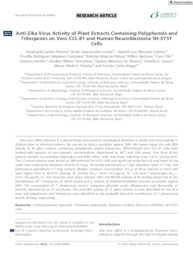Anti-Zika Virus Activity of Plant Extracts Containing Polyphenols and Triterpenes on Vero CCL-81 and Human Neuroblastoma SH-SY5Y Cells.
Anti-Zika Virus Activity of Plant Extracts Containing Polyphenols and Triterpenes on Vero CCL-81 and Human Neuroblastoma SH-SY5Y Cells.
Autoria: PEREIRA, R. S.; COSTA, V. V.; GOMES, G. L. M.; CAMPANA, P. R. V.; PÁDUA, R. M. de; BARBOSA, M.; OKI, Y.; HEIDEN, G.; FERNANDES, G. W.; OLIVEIRA, D. M. de; SOUZA, D. G.; TEIXEIRA, M. M.; BRAGA, F. C.
Resumo: Zika virus (ZIKV) infection is a global threat associated to neurological disorders in adults and microcephaly in children born to infected mothers. No vaccine or drug is available against ZIKV. We herein report the anti-ZIKV activity of 36 plant extracts containing polyphenols and/or triterpenes. ZIKV-infected Vero CCL-81 cells were treated with samples at non-cytotoxic concentrations, determined by MTT and LDH assays. One third of the extracts elicited concentration-dependent anti-ZIKV effect, with viral loads reduction from 0.4 to 3.8?log units. The 12 active extracts were tested on ZIKV-infected SH-SY5Y cells and significant reductions of viral loads (in log units) were induced by Maytenus ilicifolia (4.5?log), Terminalia phaeocarpa (3.7?log), Maytenus rigida (1.7?log) and Echinodorus grandiflorus (1.7?log) extracts. Median cytotoxic concentration (CC50) of these extracts in Vero cells were higher than in SH-SY5Y lineage. M. ilicifolia (IC50=16.8±10.3??g/mL, SI=3.4) and T. phaeocarpa (IC50=22.0±6.8??g/mL, SI=4.8) were the most active extracts. UPLC-ESI-MS/MS analysis of M. ilicifolia extract led to the identification of 7 triterpenes, of which lupeol and a mixture of friedelin/friedelinol showed no activity against ZIKV. The composition of T. phaeocarpa extract comprises phenolic acids, ellagitannins and flavonoids, as recently reported by us. In conclusion, the anti-ZIKV activity of 12 plant extracts is here described for the first time and polyphenols and triterpenes were identified as the probable bioactive constituents of T. phaeocarpa and M. ilicifolia, respectively.
Ano de publicação: 2022
Tipo de publicação: Artigo de periódico
Unidade: Embrapa Clima Temperado
Palavras-chave: Biodiversidade, Extrato Vegetal, Vírus
Observações
1 - Por padrão são exibidas publicações dos últimos 20 anos. Para encontrar publicações mais antigas, configure o filtro ano de publicação, colocando o ano a partir do qual você deseja encontrar publicações. O filtro está na coluna da esquerda na busca acima.
2 - Para ler algumas publicações da Embrapa (apenas as que estão em formato ePub), é necessário ter, no celular ou computador, um desses softwares gratuitos. Sistemas Android: Google Play Livros; IOS: iBooks; Windows e Linux: software Calibre.
Acesse outras publicações
Acesse a Base de Dados da Pesquisa Agropecuária (BDPA) para consultar o acervo completo das bibliotecas da Embrapa.

